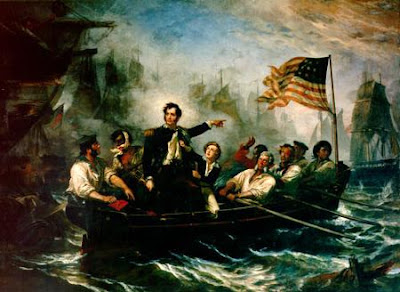



Oliver Hazard Perry was born on August 23, 1785, at the Old Perry Homestead in South Kingston, Rhode Island, of Fighting Quaker parents. His father was in the United States Navy and young Perry soon followed. At the age of 13, Perry entered the Navy as a midshipman, where his first assignment was in the Caribbean under the command of his father aboard the sloop-of-war, General Greene. Perry's subsequent voyages took him to Europe and Africa during the Barbary Wars. In 1805, at the age of 20, Perry became a lieutenant and was given the command of a small schooner. Next he was called to oversee the construction of a number of gunboats ordered by President Thomas Jefferson. When this job was successfully completed, Perry was given the command of the 14-gun vessel Revenge and cruised the northern and mid-Atlantic waters of the Eastern United States. In January 1811, Perry was ordered to survey a number of Rhode Island harbors. Unfortunately, through faulty piloting and bad weather, the Revenge wrecked on a reef. Perry requested an inactive status and an investigation. The court of inquiry found him blameless for the loss and actually applauded him for his valiant attempts to save public property. In May 1812 Perry returned to active duty and received a promotion to master-commandant. One month later the United States declared war on Great Britain, citing British policies that infringed on the American trade and freedom of the seas. He was given command of 12 gunboats at Newport and New London. Perry lost interest in the relative inactivity of this post, and, in September 1812, requested duty on the high seas or the Great Lakes. In February 1813, he was ordered to Commodore Isaac Chauncey's command at Sacket's Harbor, Lake Ontario. Perry reached Chauncey's headquarters on March 3. Because British attacks were expected momentarily, Chauncey kept Perry with him for two weeks. The attacks failed to materialize and Chauncey decided that Perry would be of better use in Erie, Pennsylvania, where a fleet was being constructed to wrest control of Lake Erie from the British who already had a small squadron there.
Although facing many adverse conditions, including lack of men and materials, Perry and his men successfully completed six vessels by July 1813. These six were joined by others from Buffalo. Two months later, on September 10, 1813, the American squadron commanded by Perry fought a British squadron commanded by Captain Robert Barclay. The Battle of Lake Erie began with Perry aboard his flagship the Lawrence. In the early stages of the battle, however, the Lawrence and her crew took most of the enemy's fire and was severely damaged; over 80 percent of Perry's crew were killed or wounded by concentrated British gunfire. In an attempt to change defeat to victory, Perry, carrying his battle flag emblazoned with Captain Lawrence's dying words "Don't Give Up The Ship" transferred from the Lawrence to the lightly damaged Niagara in a small boat. He took command of the Niagara and sailed her into the British battle line. The British had also taken heavy casualties from the Lawrence's fire. Broadsides from the fresh Niagara compelled their surrender within 15 minutes of Perry's transfer. Immediately following his victory at the Battle of Lake Erie, Perry penned the famous words, 'We have met the enemy and they are ours..." in his report to General William Henry Harrison. Perry was the first in history to defeat an entire British squadron and successfully bring back every ship to his base as a prize of war. Perry, at the age of 28, was hailed by the public as a national hero for his victory on Lake Erie. After his victory in the War of 1812, Perry was promoted to the rank of Captain and given command of the new frigate Java. Then in 1819, as commander of the John Adams, Perry was sent to Venezuela on a diplomatic mission. After completing his mission he contracted yellow fever and died at sea near Trinidad on August 23, 1819, his 34th birthday. He was buried at Port of Spain, Trinidad, with full military honors. In 1826, his remains were moved from Trinidad to Newport, Rhode Island, where a monument in his honor was erected by the state.
No comments:
Post a Comment